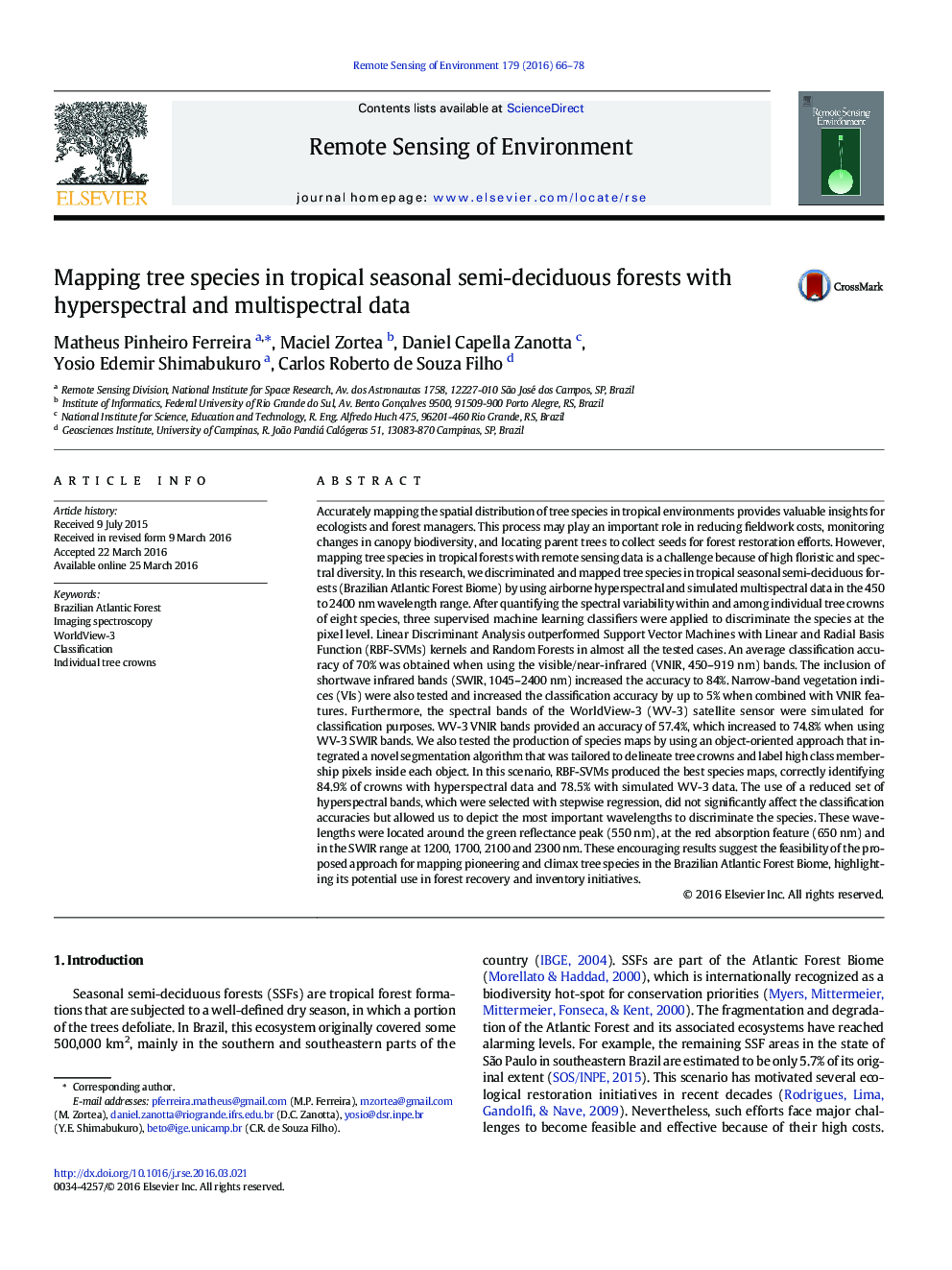| کد مقاله | کد نشریه | سال انتشار | مقاله انگلیسی | نسخه تمام متن |
|---|---|---|---|---|
| 6345464 | 1621221 | 2016 | 13 صفحه PDF | دانلود رایگان |
عنوان انگلیسی مقاله ISI
Mapping tree species in tropical seasonal semi-deciduous forests with hyperspectral and multispectral data
ترجمه فارسی عنوان
گونه های درخت درختان در جنگل های نیمه برفی فصلی گرمسیری با داده های چند بعدی و چند بعدی
دانلود مقاله + سفارش ترجمه
دانلود مقاله ISI انگلیسی
رایگان برای ایرانیان
کلمات کلیدی
موضوعات مرتبط
مهندسی و علوم پایه
علوم زمین و سیارات
کامپیوتر در علوم زمین
چکیده انگلیسی
Accurately mapping the spatial distribution of tree species in tropical environments provides valuable insights for ecologists and forest managers. This process may play an important role in reducing fieldwork costs, monitoring changes in canopy biodiversity, and locating parent trees to collect seeds for forest restoration efforts. However, mapping tree species in tropical forests with remote sensing data is a challenge because of high floristic and spectral diversity. In this research, we discriminated and mapped tree species in tropical seasonal semi-deciduous forests (Brazilian Atlantic Forest Biome) by using airborne hyperspectral and simulated multispectral data in the 450 to 2400Â nm wavelength range. After quantifying the spectral variability within and among individual tree crowns of eight species, three supervised machine learning classifiers were applied to discriminate the species at the pixel level. Linear Discriminant Analysis outperformed Support Vector Machines with Linear and Radial Basis Function (RBF-SVMs) kernels and Random Forests in almost all the tested cases. An average classification accuracy of 70% was obtained when using the visible/near-infrared (VNIR, 450-919Â nm) bands. The inclusion of shortwave infrared bands (SWIR, 1045-2400Â nm) increased the accuracy to 84%. Narrow-band vegetation indices (VIs) were also tested and increased the classification accuracy by up to 5% when combined with VNIR features. Furthermore, the spectral bands of the WorldView-3 (WV-3) satellite sensor were simulated for classification purposes. WV-3 VNIR bands provided an accuracy of 57.4%, which increased to 74.8% when using WV-3 SWIR bands. We also tested the production of species maps by using an object-oriented approach that integrated a novel segmentation algorithm that was tailored to delineate tree crowns and label high class membership pixels inside each object. In this scenario, RBF-SVMs produced the best species maps, correctly identifying 84.9% of crowns with hyperspectral data and 78.5% with simulated WV-3 data. The use of a reduced set of hyperspectral bands, which were selected with stepwise regression, did not significantly affect the classification accuracies but allowed us to depict the most important wavelengths to discriminate the species. These wavelengths were located around the green reflectance peak (550Â nm), at the red absorption feature (650Â nm) and in the SWIR range at 1200, 1700, 2100 and 2300Â nm. These encouraging results suggest the feasibility of the proposed approach for mapping pioneering and climax tree species in the Brazilian Atlantic Forest Biome, highlighting its potential use in forest recovery and inventory initiatives.
ناشر
Database: Elsevier - ScienceDirect (ساینس دایرکت)
Journal: Remote Sensing of Environment - Volume 179, 15 June 2016, Pages 66-78
Journal: Remote Sensing of Environment - Volume 179, 15 June 2016, Pages 66-78
نویسندگان
Matheus Pinheiro Ferreira, Maciel Zortea, Daniel Capella Zanotta, Yosio Edemir Shimabukuro, Carlos Roberto de Souza Filho,
